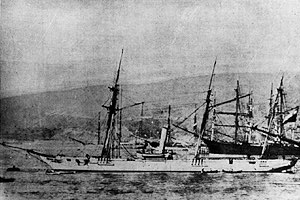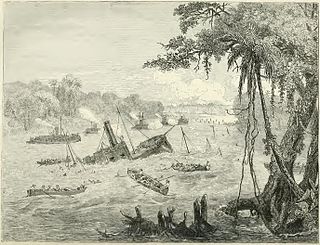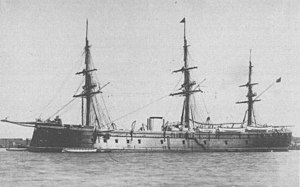
The Chincha Islands War, also known as Spanish–South American War, was a series of coastal and naval battles between Spain and its former colonies of Peru, Chile, Ecuador, and Bolivia from 1865 to 1879. The conflict began with Spain's seizure of the guano-rich Chincha Islands in one of a series of attempts by Spain, under Isabella II, to reassert its influence over its former South American colonies. The war saw the use of ironclads, including the Spanish ship Numancia, the first ironclad to circumnavigate the world.

The schooner Virgen de Covadonga was a ship that participated in the Chincha Islands War and the War of the Pacific, under Spanish and Chilean flags. She was launched in 1859. Covadonga hit a floating mine and sank off Chancay in 1880.

The Magenta class consisted of two broadside ironclads built for the French Navy in the early 1860s. They were the only ironclad two-deckers ever built, and the first ironclads to feature a naval ram.

The Brazilian ironclad Brasil was an armored corvette built in France for the Brazilian Navy in the mid-1860s. Configured as a central-battery ironclad, she served during the 1864–70 War of the Triple Alliance between Brazil, Argentina and Uruguay against Paraguay.

The Pará-class monitors were a group of six wooden-hulled ironclad monitors named after Brazilian provinces and built in Brazil for the Imperial Brazilian Navy during the Paraguayan War in the late 1860s. The first three ships finished, Pará, Alagoas and Rio Grande, participated in the Passage of Humaitá in February 1868. Afterwards the remaining ships joined the first three and they all provided fire support for the army for the rest of the war. The ships were split between the newly formed Upper Uruguay and Mato Grosso Flotillas after the war. Alagoas was transferred to Rio de Janeiro in the 1890s and participated in the Fleet Revolt of 1893–94.

Triomphante (Triumphant) was the third and last ship of the La Galissonnière class of wooden-hulled, armored corvettes built for the French Navy during the 1870s. Her construction was delayed for years and the navy took advantage of the extended construction time to upgrade her armament in comparison to the lead ship, La Galissonnière. She and her half-sister La Galissonnière participated in a number of battles during the Sino-French War of 1884–85. The ship remained in Asia and never returned to France after the war. She was condemned in 1896 and sold in 1903.

The Brazilian monitor Bahia was originally ordered by Paraguay in 1864 with the name Minerva, but was sold to Brazil when Paraguay defaulted on the payments. She participated in the 1864–70 War of the Triple Alliance between Brazil, Argentina and Uruguay against Paraguay, and took part in the Passage of Humaitá.

The Brazilian ironclad Rio de Janeiro was an armored gunboat built for the Brazilian Navy during the Paraguayan War in the mid-1860s. Like the other two gunboats she was built in Brazil and was designed as a casemate ironclad. Commissioned in April 1866, the ship did not enter combat until September, when she bombarded Paraguayan fortifications at Curuzu. Rio de Janeiro hit two mines on 2 September and rapidly sank, taking 53 of her crew with her.

The Spanish ironclad Tetuán was an armored frigate built in the royal dockyard at Ferrol during the 1860s for the Spanish Navy. She was captured by rebels during the Cantonal Revolution in 1873 and participated in the Battle off Cartagena. While under repair after the battle, the ship was destroyed by fire and broken up in 1874.

The Spanish ironclad Arapiles was a wooden-hulled armored frigate bought from England during the 1860s for the Spanish Navy. Begun as an unarmored steam frigate, she was converted into an ironclad while under construction. Damaged when she ran aground in early 1873, she was under repair in the United States during the Virginius Affair later that year as tensions rose between the US and Spain over the incident. The ship was hulked in 1879 and the poor condition of her hull forced her reconstruction to be cancelled in 1882. Arapiles was scrapped a year or two later.

The Spanish ironclad Vitoria was an iron-hulled armored frigate purchased from England during the 1860s. The ship participated on both sides during the Cantonal rebellion of 1873–1874, first on the rebel side and then after her crew surrendered to neutral warships, on the government side. She played a major role in the Battle off Cartagena for the government. Vitoria bombarded rebel towns from 1874 to 1876 during the Third Carlist War. The ship was reconstructed in the late 1890s and reclassified as a coast-defense ship, although she served as a training ship until she was scrapped in 1912.

The Spanish ironclad Sagunto was a wooden-hulled armored frigate built for the Royal Spanish Navy in the 1860s and 1870s. She was originally built as a large ship of the line, but was converted into a central-battery ironclad while still under construction. She was stricken from the naval register in 1891.

The ironclad Zaragoza was a Royal Spanish Navy wooden-hulled armored frigate completed in 1868. She later served as a training ship and was stricken from the naval register in 1896.

The Spanish ironclad Méndez Núñez was a wooden-hulled armored corvette converted from the 38-gun, steam-powered frigate Resolución during the 1860s after the ship was badly damaged during the Chincha Islands War of 1864–1866. She was captured by rebels during the Cantonal Revolution in 1873 and participated in the Battle off Cartagena before she was returned to government control after Cartagena surrendered in early 1874. The ship was stricken from the Navy List in 1886 and broken up ten years later.
BAP Victoria was an ironclad monitor built for the Peruvian Navy in the mid-1860s. The ship participated in the Battle of Callao in 1866 during the Chincha Islands War of 1864–66 and was not damaged. Her ultimate fate is unknown.

The Provence-class ironclads consisted of 10 ironclad frigates built for the French Navy during the 1860s. Only one of the sister ships was built with an wrought iron hull; the others were built in wood. By 1865 they were armed with eleven 194-millimeter (7.6 in) guns and played a minor role in the 1870–1871 Franco-Prussian War. The ships began to be disposed of in the early 1880s, although several lingered on in subsidiary roles for another decade before they followed their sisters to the scrap yard.

The French ironclad Provence was the lead ship of her class of 10 armored frigates built for the French Navy during the 1860s. Commissioned in 1865, she spent the bulk of her career with the Mediterranean Squadron, often serving as a flagship. The ironclad played a minor role in the Franco-Prussian War of 1870–1871, blockading the North Sea coast of Prussia. Provence was decommissioned after the war, but was reactivated in late 1875.

The French ironclad Héroïne was one of 10 Provence-class armored frigates built for the French Navy during the 1860s. She was the only ship of the class to be built with an iron hull. Completed in 1865, the ship was initially assigned to the Northern Squadron, sometimes serving as a flagship. The ironclad played a minor role in the Franco-Prussian War of 1870–1871, blockading the North Sea coast of Prussia and a Prussian commerce raider in a neutral Spanish port. Héroïne was decommissioned after the war, but was reactivated in 1876 and was assigned to the Mediterranean Squadron.

The French ironclad Flandre was one of ten Provence-class armored frigates built for the French Navy in the 1860s. Commissioned in 1865, she was initially assigned to the Northern Squadron and sometimes served as a flagship. The ironclad played a minor role in the Franco-Prussian War of 1870–1871, blockading the North Sea coast of Prussia. Flandre was decommissioned after the war and remained in reserve for the next decade and a half. The ship was disarmed in 1884 and was scrapped three years later.

Mahmudiye, named for Sultan Mahmud II, was the fourth of four Osmaniye-class ironclad warships built for the Ottoman Navy in the 1860s. She was the only member of her class built at the Thames Iron Works, with work lasting from her keel laying in 1863 and her launching in 1864. A broadside ironclad, Mahmudiye carried a battery of fourteen 203 mm (8 in) RML Armstrong guns and ten 36-pounder Armstrongs in a traditional broadside arrangement, with a single 229 mm (9 in) RML as a chase gun. Among the more powerful of Ottoman ironclads, the Navy decided to keep the ship safely in the Mediterranean Sea during the Russo-Turkish War of 1877–1878 to preserve the vessel. She spent the 1880s out of service, though she was heavily rebuilt in the early 1890s and converted into a more modern barbette ship. She was nevertheless in poor condition by the time of the Greco-Turkish War in 1897, as a result saw no action, and was disarmed after the war. She saw no further active service, being used briefly as a barracks ship from 1909 to 1913, when she was sold to ship breakers and dismantled.


















